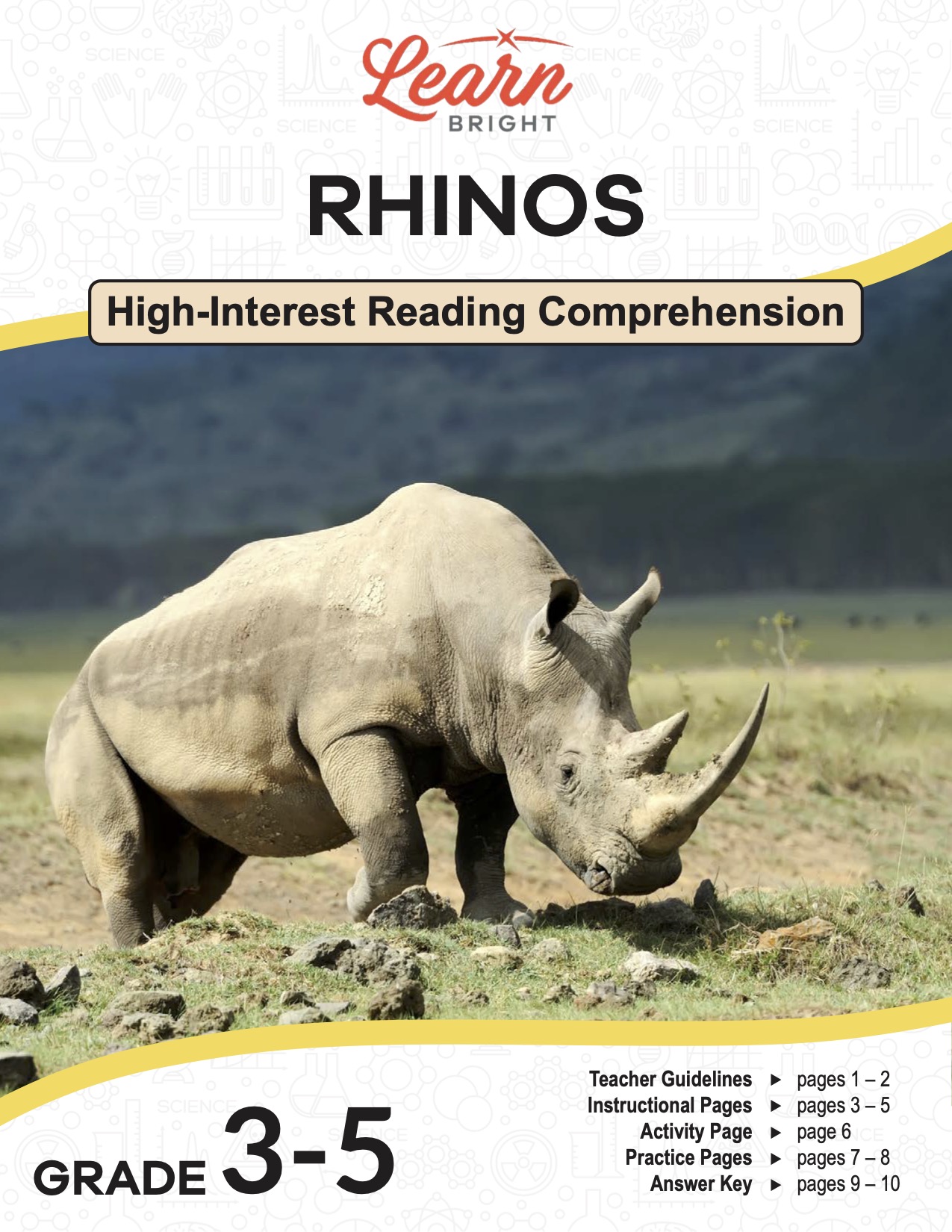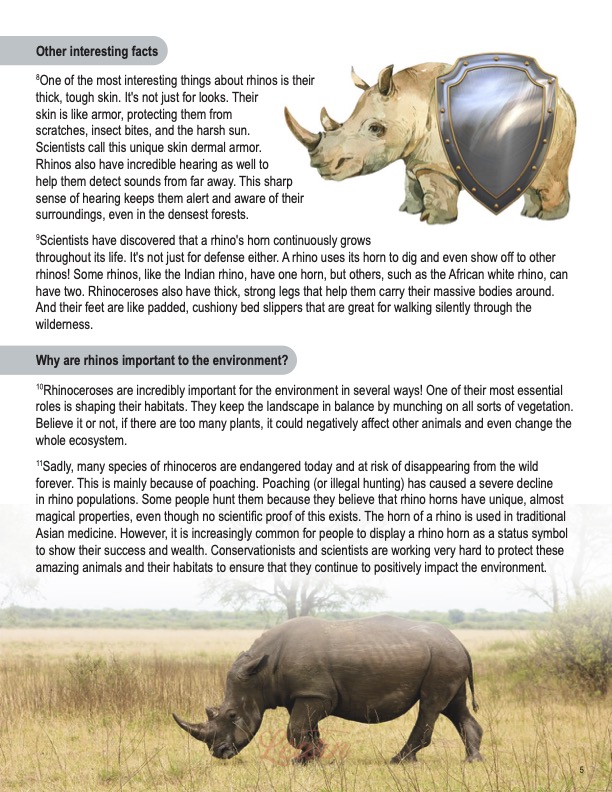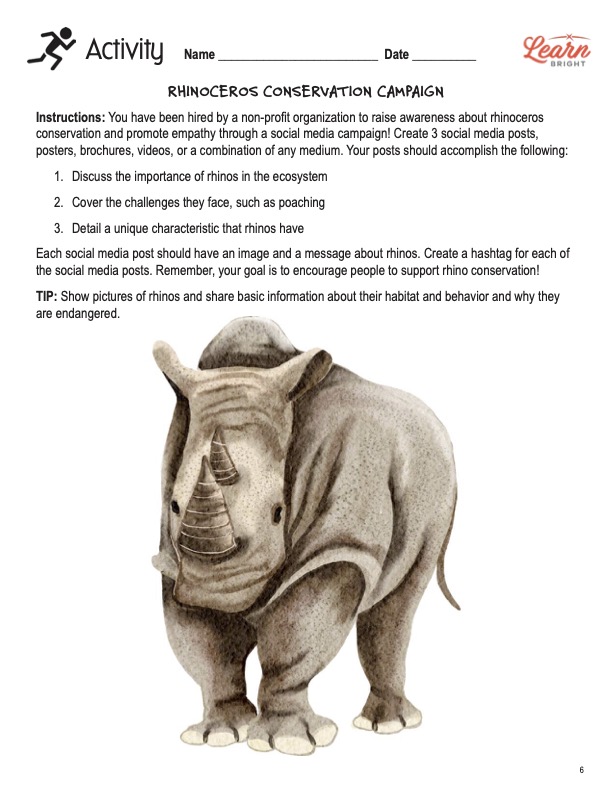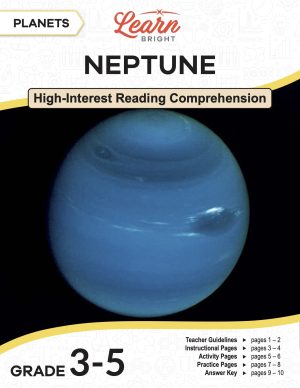Description
What our Rhinos lesson plan includes
Lesson Objectives and Overview: Rhinos is a high-interest reading comprehension lesson plan. As such, students will practice various close reading and comprehension skills. In addition, they will learn about a rhinoceros’s habitat, diet, and behaviors. This lesson is for students in 3rd grade, 4th grade, and 5th grade.
Classroom Procedure
Every lesson plan provides you with a classroom procedure page that outlines a step-by-step guide to follow. You do not have to follow the guide exactly. The guide helps you organize the lesson and details when to hand out worksheets. It also lists information in the yellow box that you might find useful. You will find the lesson objectives, state standards, and number of class sessions the lesson should take to complete in this area. In addition, it describes the supplies you will need as well as what and how you need to prepare beforehand.
Teacher Notes
The teacher notes page provides an extra paragraph of information to help guide the lesson. It explains that you can teach this lesson in a whole-class setting or as an independent, small-group activity. You can use the blank lines to write down any other ideas or thoughts you have about the topic as you prepare.
RHINOS LESSON PLAN CONTENT PAGES
What Is a Rhinoceros?
The Rhinos lesson plan contains three content pages. It begins by providing a box of background information about this cool animal. This mammal lives in Africa and Asia. Rhinos are herbivores and only eat vegetation. In general, they can live for up to 50 years.
Rhinoceroses (rhinos for short) are fascinating creatures with a unique set of physical characteristics. One of their most distinctive features is their tough, grayish, and wrinkled skin. This skin helps protect them from the elements of their environment. Underneath this rugged exterior, rhinos have strong, muscular bodies that allow them to charge at high speeds when they feel threatened. In short bursts, they can run up to 30 miles per hour!
Perhaps the most iconic feature of rhinos are their large, pointy horns, which are made of a material called keratin. Like our fingernails and hair, rhinos’ horns keep growing throughout their lives. They use these horns for various purposes, including digging for water and minerals, defending their territory from other rhinos, and sometimes even protecting their young. Sadly, these impressive horns have made them a target for poachers who hunt them for their valuable horns. In some cultures, the horns are believed to have special healing powers.
More Rhino Characteristics
In addition to their unique skin and horns, rhinoceroses have short, stocky legs that support their massive bodies. Their legs are well suited for running when necessary, but rhinos are generally known for their slower, lumbering pace. They also possess fairly large, expressive ears that can swivel in different directions. Their ears help them pick up sounds from their surroundings, alerting them to potential dangers or to the presence of other animals.
Rhinos usually live in savannas, grasslands, and even African and Asian forests. They like to be where there’s plenty of green grass to munch on. Sometimes, they take mud baths to keep cool and protect their skin from the sun. The impressive beasts are solitary animals, so they usually live alone. But sometimes they gather in small groups, especially when a female rhino has a baby.
When caring for their little ones, rhino moms are very protective. They use their muscular bodies to keep their babies safe from danger. Baby rhinos, called calves, stay close to their moms. While in their mother’s care, they learn how to find food and stay safe in the wild. It’s like going to school with their mom as their teacher!
Diet of a Rhinoceros
Rhinos are herbivores, which means they have a plant-based diet. These big, strong animals mainly munch on vegetation like grass, leaves, branches, and fruits. Scientists consider the rhino both a browser and a grazer. Grazing refers to when rhinos nibble on grass and other plants on the ground. But they also browse, which means they use their strong lips and teeth to pluck leaves and branches from trees and bushes. You could think of them like the giant lawnmowers of the savanna.
And they’re not too picky—if it’s a yummy plant, a rhinoceros will try it! A rhino can find food in various places because it lives in multiple habitats, from grassy savannas to dense forests. Rhinoceroses have a keen sense of smell, which helps them locate the tastiest plants to chow down on. So, whether it’s a grassy meadow or a leafy tree, rhinos are experts at finding their favorite snacks!
Other Interesting Facts
One of the most interesting things about rhinos is their thick, tough skin. It’s not just for looks. Their skin is like armor, protecting them from scratches, insect bites, and the harsh sun. Scientists call this unique skin dermal armor. Rhinos also have incredible hearing as well to help them detect sounds from far away. This sharp sense of hearing keeps them alert and aware of their surroundings, even in the densest forests.
Scientists have discovered that a rhino’s horn continuously grows throughout its life. It’s not just for defense either. A rhino uses its horn to dig and even show off to other rhinos! Some rhinos, like the Indian rhino, have one horn, but others, such as the African white rhino, can have two. Rhinoceroses also have thick, strong legs that help them carry their massive bodies around. And their feet are like padded, cushiony bed slippers that are great for walking silently through the wilderness.
Why Rhinos Are Important
Rhinoceroses are incredibly important for the environment in several ways! One of their most essential roles is shaping their habitats. They keep the landscape in balance by munching on all sorts of vegetation. Believe it or not, if there are too many plants, it could negatively affect other animals and even change the whole ecosystem.
Sadly, many species of rhinoceros are endangered today and at risk of disappearing from the wild forever. This is mainly because of poaching. Poaching (or illegal hunting) has caused a severe decline in rhino populations. Some people hunt them because they believe that rhino horns have unique, almost magical properties, even though no scientific proof of this exists. The horn of a rhino is used in traditional Asian medicine.
However, it is increasingly common for people to display a rhino horn as a status symbol to show their success and wealth. Conservationists and scientists are working very hard to protect these amazing animals and their habitats to ensure that they continue to positively impact the environment.
RHINOS LESSON PLAN WORKSHEETS
The Rhinos lesson plan includes two worksheets: an activity worksheet and a practice worksheet. Each one will help students solidify their grasp of the material they learned throughout the lesson. You can refer to the classroom procedure guidelines to know when to hand out each worksheet.
CONSERVATION CAMPAIGN ACTIVITY WORKSHEET
For this activity, students will pretend they’ve been hired by a non-profit organization. Their goal is to raise awareness about the conservation of rhinos and promote empathy through a social media campaign. They will create three social media posts, posters, brochures, or other medium in any combination. Students should follow the guidelines on the worksheet as they complete the project.
RHINOS PRACTICE WORKSHEET
The practice worksheet requires students to answer a series of 11 questions. These questions all relate to the content pages, so students will need to refer to them often for the answers. In addition, each question provides which reading tool the question corresponds to, such as text feature, vocabulary, or comprehension.
Worksheet Answer Keys
At the end of the lesson plan document is an answer key for the practice worksheet. The correct answers are all in red to make it easier for you to compare them with students’ responses. If you choose to administer the lesson pages to your students via PDF, you will need to save a new file that omits these pages. Otherwise, you can simply print out the applicable pages and keep these as reference for yourself when grading assignments.










